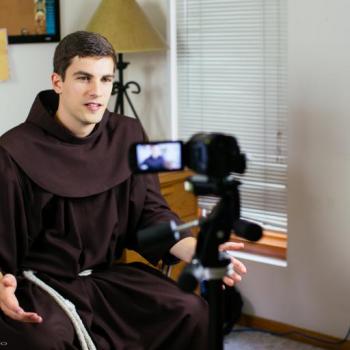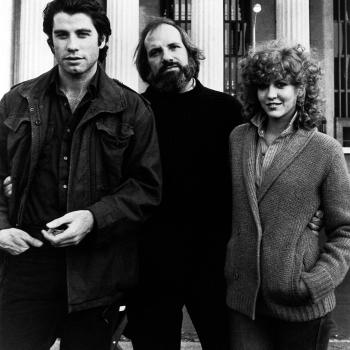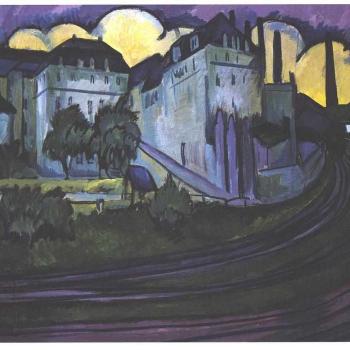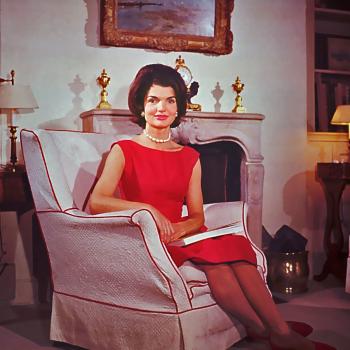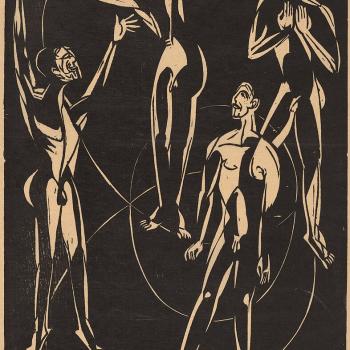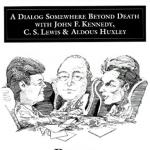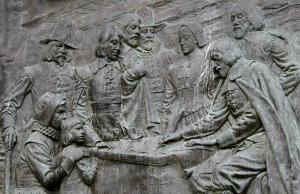
Source: Flicker user David
License
Eli Roth’s Thanksgiving (2023) is a holiday success story. This is your classic popcorn slasher, a diverting blend of blood and laughs to go with your salty treats ‘fore the big screen. We’ve got shocking kills, eye-popping gore (with some practical effects!), and a mystery that holds its own. In the spirit of 80s and 90s slashers, it’s willing to be funny and irreverent without pretending to be something it’s not. That’s what really makes this gem about a man dressed as John Carver, the first governor of Plymouth Colony, chasing down teens and townies in Plymouth, Massachusetts work so well. It displaces its holiday theme, seeks to entertain without getting all “elevated.”
Think, dear reader. Think how easy it would have been to make a Thanksgiving slasher about the spirit of colonial violence in which every line (even every pause!) focused on the horrific legacy of settler-colonialism. Town elders could tell tales of Algonquin and Calvinists alike chowing down on brightly colored corn only for a Sydney Sweeney-esque teen to remind us that, actually, the Pilgrims were religious zealots bent on ensuring God’s enemies went straight to their predestined afterlife. Speeches! Orations even! Maybe the teens could’ve gone to the town archives and found a contract between YHWH and John Carver in which they mutually swore to salt the earth lest the City on the Hill fall to the savageries of heathenism. In the end, I see Ibram X. Kendi, emerging from his troubled Boston think tank, reading Antiracist Baby to all Plymouth’s little ones. We close (I can picture it now) on a shot of the town’s inhabitants, thoroughly reformed (though not Reformed), dressed as Pilgrims and Indians, building a STEM community center on top of Plymouth Rock.
I’m struggling to make this alternate-universe film sound as boring as it is in my mind. The problem is not taking on the difficult history and legacy of this holiday. The Pilgrims were deranged Calvinist settlers (see 2015’s The VVitch). The US is built on the bones of countless peoples who once occupied this vast land. My fear is didacticism, the meeting of meaning and symbol such that there is no ambiguity. In our moment, it is too easy for genre film to become boringly starved tripe, projected images intended only to help the audience pat themselves on the back. For such movies, there is no ambiguity, no rumination, and rarely even any entertainment. We see the trauma. We allegorize the trauma. We clap.
Roth deftly avoids that pitfall by relegating these dimensions of Thanksgiving to the periphery. The opening set piece occurs on Black Friday with unexpectedly horrific results. Through this outburst of violence, the town becomes conscious of its own sin. Before these events, however, we find ourselves at a Thanksgiving dinner where many of the film’s central teen characters are present, along with their families and family friends, including Mitch Collins (Ty Olsson), a manager at RightMart who must work because a coworker has called out. Thomas Wright (Rick Hoffmann), the father of Jessica (Nell Verlaque), owns the store and insists that it stay open. When chaos breaks loose, he shows no remorse; the next year he promises to keep the lights on. A few deaths won’t stand in the way of profits. Thanksgiving itself is the killer’s obsession. He bases his murders and his planned finale on a twisted, Rocky Horror Picture Show (1975) variation of the holiday. In this telling, the original sin is exploitation and the consumption it engenders and feeds on. No profits, no death.
Outside the RightMart, the people of Plymouth wait their turn in classic Masshole fashion. They scream and threaten each other, lurching into the barricades, until the teens (again, connected to the store owner and manager) sneak in. Enraged by this preferential treatment, one of the crowd grabs a megaphone from a worker and screams that the store is open. On the one hand, this bull rush causes the violence that kickstarts the film’s plot. People become monstrous when reduced to consumers, able only to turn on one another. On the other, it is a reasonable expression of anger. They’ve been standing in the cold for hours while these kids take the pick of the litter because they know or are related to those in power.
The actual story of Thanksgiving comes up only once when one of the jock teens has a classmate write a report on the holiday to be recited in class. Mr. Athlete hasn’t been paying for the nerd’s services, and so he gets a bit of revenge: the essay is just a post from the teacher’s blog. In one sense, this bit is played for laughs: the jock gets his comeuppance—haha. More than that, however, the scene reminds us of how un-seriously we take a reality that is, by now, well known. The United States is a product of settler-colonial violence. The Pilgrims (again) were Calvinist zealots. But what difference is that making to these kids? How is that changing their lives in suburban Massachusetts? What is acknowledging the truth doing here? Is anyone taking any action?
This historical paralysis haunts the film. John Carver is back to seek vengeance not for the passengers of the Mayflower nor for King Philip. His motives are personal, and his identity (not that I’m going to give it away) contains further (though oblique) social commentary. Ole Governor John’s crusade says more about what Thanksgiving is than any didactic posturing could. We get the bloody mess we deserve.





